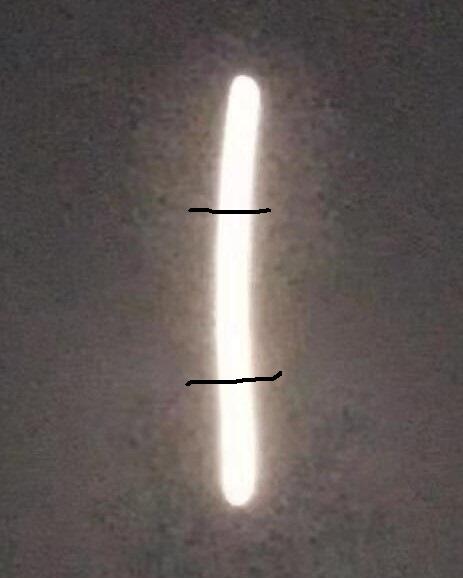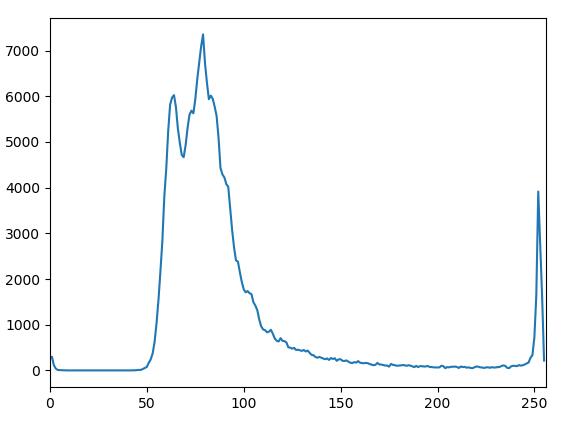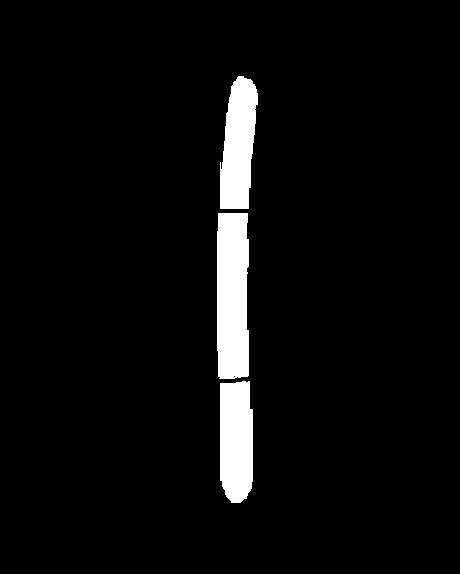算法中,初始种子可自动选择(通过不同的划分可以得到不同的种子,可按照自己需要改进算法),图分别为原图(自己画了两笔为了分割成不同区域)、灰度图直方图、初始种子图、区域生长结果图。
另外,不管时初始种子选择还是区域生长,阈值选择很重要。
|
1
2
3
4
5
6
7
8
9
10
11
12
13
14
15
16
17
18
19
20
21
22
23
24
25
26
27
28
29
30
31
32
33
34
35
36
37
38
39
40
41
42
43
44
45
46
47
48
49
50
51
52
53
54
55
56
57
58
59
60
61
62
63
64
65
66
67
68
69
70
71
72
73
74
75
76
77
78
79
|
import cv2import numpy as npimport matplotlib.pyplot as plt#初始种子选择def originalSeed(gray, th): ret, thresh = cv2.cv2.threshold(gray, th, 255, cv2.THRESH_BINARY)#二值图,种子区域(不同划分可获得不同种子) kernel = cv2.getStructuringElement(cv2.MORPH_ELLIPSE, (3,3))#3×3结构元 thresh_copy = thresh.copy() #复制thresh_A到thresh_copy thresh_B = np.zeros(gray.shape, np.uint8) #thresh_B大小与A相同,像素值为0 seeds = [ ] #为了记录种子坐标 #循环,直到thresh_copy中的像素值全部为0 while thresh_copy.any(): Xa_copy, Ya_copy = np.where(thresh_copy > 0) #thresh_A_copy中值为255的像素的坐标 thresh_B[Xa_copy[0], Ya_copy[0]] = 255 #选取第一个点,并将thresh_B中对应像素值改为255 #连通分量算法,先对thresh_B进行膨胀,再和thresh执行and操作(取交集) for i in range(200): dilation_B = cv2.dilate(thresh_B, kernel, iterations=1) thresh_B = cv2.bitwise_and(thresh, dilation_B) #取thresh_B值为255的像素坐标,并将thresh_copy中对应坐标像素值变为0 Xb, Yb = np.where(thresh_B > 0) thresh_copy[Xb, Yb] = 0 #循环,在thresh_B中只有一个像素点时停止 while str(thresh_B.tolist()).count("255") > 1: thresh_B = cv2.erode(thresh_B, kernel, iterations=1) #腐蚀操作 X_seed, Y_seed = np.where(thresh_B > 0) #取处种子坐标 if X_seed.size > 0 and Y_seed.size > 0: seeds.append((X_seed[0], Y_seed[0]))#将种子坐标写入seeds thresh_B[Xb, Yb] = 0 #将thresh_B像素值置零 return seeds#区域生长def regionGrow(gray, seeds, thresh, p): seedMark = np.zeros(gray.shape) #八邻域 if p == 8: connection = [(-1, -1), (-1, 0), (-1, 1), (0, 1), (1, 1), (1, 0), (1, -1), (0, -1)] elif p == 4: connection = [(-1, 0), (0, 1), (1, 0), (0, -1)] #seeds内无元素时候生长停止 while len(seeds) != 0: #栈顶元素出栈 pt = seeds.pop(0) for i in range(p): tmpX = pt[0] + connection[i][0] tmpY = pt[1] + connection[i][1] #检测边界点 if tmpX < 0 or tmpY < 0 or tmpX >= gray.shape[0] or tmpY >= gray.shape[1]: continue if abs(int(gray[tmpX, tmpY]) - int(gray[pt])) < thresh and seedMark[tmpX, tmpY] == 0: seedMark[tmpX, tmpY] = 255 seeds.append((tmpX, tmpY)) return seedMarkpath = "_rg.jpg"img = cv2.imread(path)gray = cv2.cvtColor(img, cv2.COLOR_BGR2GRAY)#hist = cv2.calcHist([gray], [0], None, [256], [0,256])#直方图seeds = originalSeed(gray, th=253)seedMark = regionGrow(gray, seeds, thresh=3, p=8)#plt.plot(hist)#plt.xlim([0, 256])#plt.show()cv2.imshow("seedMark", seedMark)cv2.waitKey(0) |




以上这篇关于初始种子自动选取的区域生长实例(python+opencv)就是小编分享给大家的全部内容了,希望能给大家一个参考,也希望大家多多支持服务器之家。
原文链接:https://www.cnblogs.com/er-gou-zi/p/12016951.html









